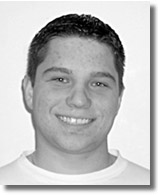Without Mac Duff, famed double-eagle must get ax

By Connor Doyle
The UA football program finds itself at a crossroads.
The Dick Tomey years were characterized by the stringent double-eagle flex defense, also known as the "Desert Swarm."
John Mackovic is not Dick Tomey.
The new coach prefers the spread offense to spreading defenders. He has more or less admitted that he's not a defensive coach. He wants to call the plays on offense, and wants a defensive coordinator to take care of the other side of the ball.
Mackovic thought he had that coordinator in longtime Tomey assistant Duane Akina. In a surprising move, Akina decided that his time at Arizona had passed and left less than a month before spring practice was to start.
Clearly, Akina's untimely departure is going to throw a wrench in Arizona's defensive plans this year. The double-eagle flex is easily the most complex scheme in college football.
Normally, a program like Arizona would look to smaller schools to find a replacement. The only problem is that no other team in the country, professional or collegiate, runs the double-eagle flex, a system so complex that it often confused those most familiar with it.
Since the beginning of the Tomey era, it has been synonymous with Arizona football. The one person most familiar with teaching the system - Akina - is sitting pretty in Texas now.
The only hope for the salvation of the complex scheme is Larry Mac Duff, currently the special teams coach of the NFL's New York Giants.
Mac Duff has been credited with helping create the innovative defense. He's likely the leading candidate to fill Akina's spot. He's said that he'll take the job if it's offered.
However, the time remaining before the players start practicing is worrisome. Spring practice starts March 24.
While most of the players on the defense have played under the system, Mac Duff will likely want to run the defense his own way.
Within a system like the double-eagle flex, teaching the players "his way" would take longer than the two-and-a-half weeks remaining before practices start. That said, the Wildcats shouldn't limit themselves to one scheme, especially when it's one of the most complicated sets in football.
If the Wildcats can't land Mac Duff, maybe it's time to change sets. Why keep tradition for tradition's sake when there could be a coordinator out there who knows how to run a better scheme?
If the new defensive coordinator were to instead move to a standard set, like the 3-4, 4-3 or the 5-2 - which would most resemble the old system - it would soften the learning curve for his players.
If the Wildcats do hire Mac Duff, I see no way in which the set could be reinstated quickly enough to make spring practice effective. Maybe he could switch his style, too.
Think about it - under a two-set system, players would learn to play defense his way instead of drawing comparison's with Akina's methods. Mac Duff would have the proverbial "clean slate" with this team.
Don't mess with tradition, success of double-eagle

By Ryan Finley
Arizona doesn't have much in terms of sports tradition.
The "Bear Down" tradition, wearing red to home games and hard-nosed defense are just about the only three legacies that UA football has right now. New head coach John Mackovic would be silly to throw away Arizona's only football legacy - the double-eagle flex defense.
Who else uses the defense, which relies on heavy shifting at the line of scrimmage? Nobody.
The defensive style is an intricate system. It is, by all accounts, incredibly complicated to learn and harder to execute successfully. When run properly, the double eagle-flex defense is as unstoppable as any in football. Remember the "Desert Swarm" teams with Tedy Bruschi, Brandon Sanders and Tony Bouie? They ran the double-eagle flex to perfection and - no matter what offensive coordinators threw at them - they seemed to steamroll the competition.
Even this year's team, which had the offensive production of an XFL squad, could compete in games because the defense kept opponents at bay. Despite the team's anemic scoring offense, the defense managed to go 5-6. Not too bad.
Mackovic is seen by many as an offensive genius. He has promised to bring a high-octane passing attack to a program that will have two talented quarterbacks, sophomore John Rattay and incoming freshman Nic Costa.
To ruin a defensive scheme that has been as much a part of Arizona football as its ghastly white helmets would be a slam to Arizona fans, alumni and players.
The UA players - for the most part - know how to run this intricate system. By shifting the defensive scheme, Mackovic would leave his players prone to being overpowered every week.
The double-eagle flex defense relies on quick defensive linemen and Arizona recruits mostly smaller, quicker defensive players. By switching to a system that would rely on head-to-head battles between undersized defenders and massive offensive lineman, Mackovic would leave his defense prone to being slammed by high-powered offenses at UCLA, USC, Oregon and Oregon State.
The only way for the Wildcats to stay competitive in the Pacific 10 Conference next year would be to stick with the current defense and hire Larry Mac Duff, one of few people familiar with operating the defense.
Coach Mackovic has changed a lot of things since he came to Tucson in early December. But he must remember this - it wasn't the Wildcat defense that did the team in. It was the lack of offense that cost Tomey his job and Arizona a bowl bid.
Coach Mackovic doesn't pretend to know too much about defense, the one lasting tradition in recent UA football history. If it isn't broken, why fix it?